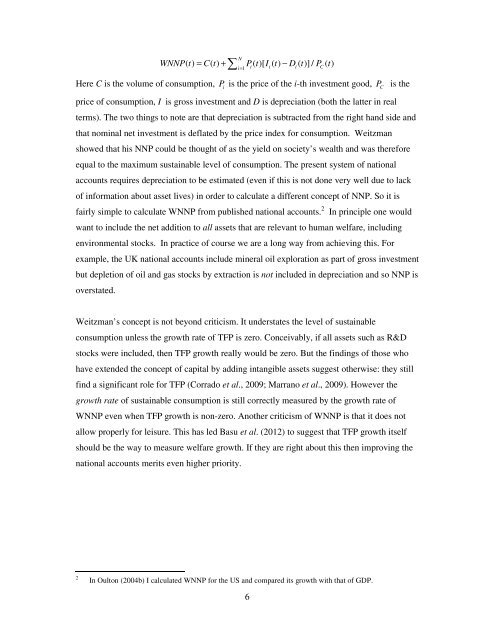Create successful ePaper yourself
Turn your PDF publications into a flip-book with our unique Google optimized e-Paper software.
∑<br />
N<br />
WNNP( t) = C( t) + P( t)[ I ( t) − D ( t)] / P ( t)<br />
i=<br />
1 i i i C<br />
Here C is the volume of consumption, i P is the price of the i-th investment good, P C is the<br />
price of consumption, I is gross investment and D is depreciation (both the latter in real<br />
terms). The two things to note are that depreciation is subtracted from the right hand side and<br />
that nominal net investment is deflated by the price index for consumption. Weitzman<br />
showed that his NNP could be thought of as the yield on society’s wealth and was therefore<br />
equal to the maximum sustainable level of consumption. The present system of national<br />
accounts requires depreciation to be estimated (even if this is not done very well due to lack<br />
of information about asset lives) in order to calculate a different concept of NNP. So it is<br />
fairly simple to calculate WNNP from published national accounts. 2 In principle one would<br />
want to include the net addition to all assets that are relevant to human welfare, including<br />
environmental stocks. In practice of course we are a long way from achieving this. For<br />
example, the UK national accounts include mineral oil exploration as part of gross investment<br />
but depletion of oil and gas stocks by extraction is not included in depreciation and so NNP is<br />
overstated.<br />
Weitzman’s concept is not beyond criticism. It understates the level of sustainable<br />
consumption unless the growth rate of TFP is zero. Conceivably, if all assets such as R&D<br />
stocks were included, then TFP growth really would be zero. But the findings of those who<br />
have extended the concept of capital by adding intangible assets suggest otherwise: they still<br />
find a significant role for TFP (Corrado et al., 2009; Marrano et al., 2009). However the<br />
growth rate of sustainable consumption is still correctly measured by the growth rate of<br />
WNNP even when TFP growth is non-zero. Another criticism of WNNP is that it does not<br />
allow properly for leisure. This has led Basu et al. (2012) to suggest that TFP growth itself<br />
should be the way to measure welfare growth. If they are right about this then improving the<br />
national accounts merits even higher priority.<br />
2 In Oulton (2004b) I calculated WNNP for the US and compared its growth with that of GDP.<br />
6


